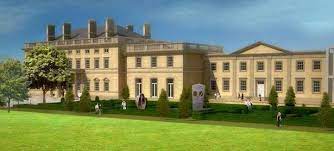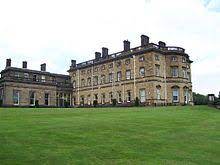
In 1720 Diana Blackett (1703-1742), the daughter of Sir William Blackett, married Sir William Wentworth and thus became mistress of Bretton Hall, near Wakefield. The Wentworths were long established members of the middle-ranking Yorkshire gentry, and had owned Bretton for over three hundred years. Sir William’s younger brother, Lt.-General Thomas Wentworth, later British ambassador to Turin, in 1720 became the owner, through his wife’s inheritance, of waste land in Surrey that is now known as The Wentworth Estate. The estate includes the world-famous golf course, and is one of the most expensive pieces of real estate in the United Kingdom. Unfortunately Gen. Wentworth’s widow sold it for £60 in 1761. Another member of the Wentworth family, John Wentworth (1737-1820), was the Royal Governor of New Hampshire. In 1772 he made a grant of land which he named Bretton Woods, after the home of his ancestors. Bretton Woods found fame in 1944 as the venue for the conference that established a system of international monetary management and the creation of the International Monetary Fund (IMF) and the International Bank for Reconstruction and Development (IBRD), which is now part of the World Bank.
The marriage to Diana brought considerable wealth into the Wentworth family, and Sir William set about designing and building the present hall, demolishing the old house and chapel in the process. On Sir William’s death in 1763, the estate passed to his son, Sir Thomas Wentworth, who established the lakes and parkland that are still a feature of Bretton Hall. In 1777, on the death of Sir Walter Calverley Blackett without a male heir, the vast estates of Sir William Blackett passed to Sir Thomas Wentworth, who duly changed his name to Blackett in accordance with Sir William’s Will. Sir Thomas used some of this inheritance to extend the property.
Diana, an illegitimate daughter of Sir Thomas, inherited his estate on his death in 1792. Diana and her husband, Thomas Richard Beaumont, considerably expanded the house, and Diana, a keen horticulturalist, commissioned a giant domed conservatory, the largest of its kind in the world, which is said to have been the prototype for the Crystal Palace in London. Diana was not the most popular of women, and was often referred to behind her back as “Madame Beaumont” due to her proud and ostentatious nature.
By then a widow, she died in 1831, leaving her estates to her son, Thomas Wentworth Beaumont, one of whose first acts was to auction off many of his mother’s artefacts, including the famous conservatory. He, and later his son, Wentworth Blackett Beaumont, continued to improve the house and its grounds, and the house remained in the hands of the Beaumont family until it was sold in 1948 by Wentworth Henry Canning Beaumont, Viscount Allendale, to West Riding County Council, who converted it into an arts college. In 2001 it merged with Leeds University and in 2007 was sold to Wakefield Metropolitan District Council. Plans to convert it into a luxury hotel were approved in 2013.

Bretton Hall was the location for part of Ken Russell’s 1969 film, “Women in Love”. It was also the subject of a lengthy poem, The new way of courting concerning Bretton Hall, written by Jimmy Mann. A handwritten copy of this dated 2 January 1874 is held by Nigel Aspdin, to whom we are indebted for the information, and whose ancestors hail from Wakefield, near to Bretton. It seems, however, that this was a copy of the original poem, as the ballad was referred to in an article by Mrs. S. C. Hall in St. James’s Magazine published in 1867. None of the Wentworth Blacketts who owned Bretton Hall appear to fit the subject of the ballad, which may therefore be apocryphal and based on earlier folk lore.
